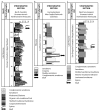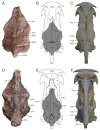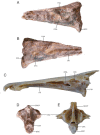Palaeontological evidence for the last temporal occurrence of the ancient western Amazonian river outflow into the Caribbean
- PMID: 24098778
- PMCID: PMC3786985
- DOI: 10.1371/journal.pone.0076202
Palaeontological evidence for the last temporal occurrence of the ancient western Amazonian river outflow into the Caribbean
Abstract
Fossil catfishes from fluvio-lacustrine facies of late Miocene Urumaco, early Pliocene Castilletes and late Pliocene San Gregorio formations provide evidence of a hydrographic connection in what is today desert regions of northern Colombia and Venezuela. New discoveries and reevaluation of existing materials leads to the recognition of two new records of the pimelodid Brachyplatystoma cf. vaillantii, and of three distinct doradid taxa: Doraops sp., Rhinodoras sp., and an unidentified third form. The presence of fossil goliath long-whiskered catfishes and thorny catfishes are indicative of the persistence of a fluvial drainage system inflow into the South Caribbean during the Pliocene/Pleistocene boundary, complementary to the previous western Amazonian hydrographic system described from the Middle Miocene Villavieja Formation in central Colombia and Late Miocene Urumaco Formation in northwestern Venezuela. The Pliocene Castilletes and San Gregorio formations potentially represent the last lithostratigraphic units related with an ancient western Amazonian fish fauna and that drainage system in the Caribbean. Alternatively, it may preserve faunas from a smaller, peripheral river basin that was cut off earlier from the Amazon-Orinoco, today found in the Maracaibo basin and the Magdalena Rivers.
Conflict of interest statement
Figures










References
-
- Albert JS, Reis RE (2011) Historical biogeography of Neotropical freshwater fishes. University of California Press. 308pp.
-
- Díaz de Gamero ML (1996) The changing course of the Orinoco River during the Neogene: a review. Palaeogeogr Palaeoclimatol Palaeoecol 123: 385-402. doi:10.1016/0031-0182(96)00115-0. - DOI
-
- Lundberg JG, Marshall LG, Guerrero J, Horton B, Malanarba MC, Wesselingh F (1998) The stage for Neotropical fish diversification: a history of tropical South American rivers. In: Malabarba LR, Reis RE, Vari RP, Lucena ZM, Lucena CAS. Phylogeny and classification of Neotropical fishes. Porto Alegre: Edipucrs. pp. 13-48.
-
- Rod E (1981) Notes on the shifting course of the ancient Rio Orinoco from late Cretaceous to Oligocene time. Geos 26: 54-56.
-
- Hoorn C (1993) Marine incursions and the influence of Andean tectonics on the Miocene depositional history of northwestern Amazonia: results of a palynostratigraphic study. Palaeogeogr Palaeoclimatol Palaeoecol 105: 267-309. doi:10.1016/0031-0182(93)90087-Y. - DOI
Publication types
MeSH terms
LinkOut - more resources
Full Text Sources
Other Literature Sources

